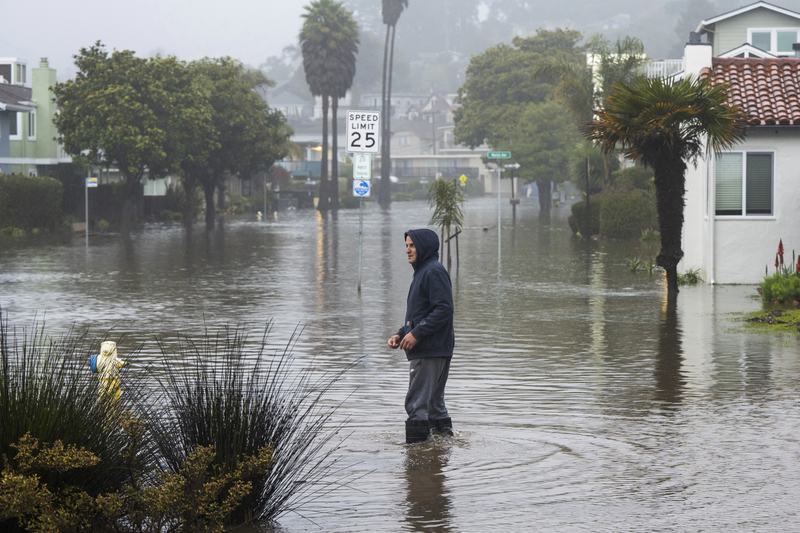Dr. Melissa Harris-Perry: You're still with The Takeaway and it's time to look back at it and give you some updates on the stories we've been following.
Last week we talked about the California water crisis, and this time it's not about a drought. Since Christmas 10 atmospheric river events have inundated the golden state. Marked by some of the rainiest days in California history, mudslides and intense flooding triggered a state of emergency from California Governor Gavin Newsom, who says the state is facing unprecedented times.
Governor Gavin Newsom: We've had less people die in the last two years of major wildfires in California that have died since New Year's Day related to this weather in California.
Dr. Melissa Harris-Perry: The storm's destruction prompted President Biden's decision to travel to California today, where he'll survey damage to see where additional resources are needed. Despite their destruction, California's parade of storms has made up for lost time. For cities like San Francisco, rainfall totals between Christmas and today have already amounted to over half the annual average. Experts like Carlin Nemeth say the state's stuck in what seems like an impossible situation.
Carlin Nemeth: California's experiencing coincidentally, both a drought emergency and a flood emergency.
Dr. Melissa Harris-Perry: The storms have reduced the severity of the state's ongoing drought but according to the National Oceanic Atmospheric Administration, it hasn't entirely solved it. Some of the rain has refilled heavily depleted reservoirs, snow packs, and aquifers in more remote areas of the state. In major urban areas like LA and in the Bay Area, the majority of rainwater is funneled right down storm drains, and into the ocean. That's something the governor hopes to change.
Governor Gavin Newsom: This weather whiplash is that new reality, and that new reality brings itself, I think, to a new reality of expectation in terms of how we manage these storms and these challenges and how we deal with hydrology going forward in terms of stormwater capture, rainwater capture, how we address these floods in terms of banking the water for the future.
Dr. Melissa Harris-Perry: Of course, questions of water management are not just a West Coast issue. Last week we looked at how cold winter weather in Jackson, Mississippi damaged the city's water pipes, leaving many residents without water and disrupting the start of the spring semester for students in Jackson's public schools. Now, there's a new water crisis in Arizona. Right outside of Phoenix the city of Scottsdale cut off the water supply to several thousand homes in the Rio Verde foothills.
Earlier in 2022, city officials in Scottsdale warned Rio Verde residents that due to drop restrictions on the Colorado River, the city would begin prioritizing its own residents and there wasn't going to be enough water to go around.
It told the unincorporated Rio Verde community that its water supply would be cut off effective January 1st. Just before its agreement was set to expire, residents in Rio Verde pled their case to the Scottsdale City Council with a certain urgency.
Resident: Within a matter of days, our water tanks in our homes will be dry, but this is avoidable. We have water in the CAP. We just need Scottsdale to process that water.
Dr. Melissa Harris-Perry: Communities in the southwest aren't the only ones facing shortages. Earlier this week we talked about how [unintelligible 00:03:38] shortages have sent prices skyrocketing, and in December we unpacked the new shortage facing families across the country. Cold medicine, winter's triple-demic of respiratory infections sounded the alarm for the FDA to make sure enough medicine was being produced, and the White House suggested it had everything handled.
Participant: Drug shortages are not uncommon and is something the administration is regularly monitoring. The FDA is always tracking shortages at the national level and works closely with manufacturers to understand their production.
Dr. Melissa Harris-Perry: Despite the White House's assurances, drug supplies haven't quite stabilized. We're not talking here just about pain relievers and cough medicine, cancer treatments, antibiotics, and prescription drugs like Adderall have all become harder to fill since December. According to the FDA, there are still nationwide shortages for over 100 drugs, and the US isn't alone. Much of Europe, China, and Australia have joined our ranks reporting widespread medicine shortages triggered by hiccups in the global supply chain. All right, Takeaway. You're up to date.
[music]
Copyright © 2023 New York Public Radio. All rights reserved. Visit our website terms of use at www.wnyc.org for further information.
New York Public Radio transcripts are created on a rush deadline, often by contractors. This text may not be in its final form and may be updated or revised in the future. Accuracy and availability may vary. The authoritative record of New York Public Radio’s programming is the audio record.

